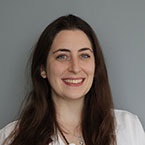By: Marissa Di Giovine, MD, FAAP & Eva Catenaccio, MD
Epilepsy, also called seizure disorder, is the most common childhood brain disorder in the United States. Nearly 3 million Americans have epilepsy. About 450,000 of them are under 17 years old.
Epilepsy can cause repeated seizures, which are sudden surges of electrical activity in the brain. About two-thirds of all children with epilepsy outgrow their
seizures by the time they are teenagers. For some, though, epilepsy may be a lifelong condition. It is important for parents to partner with their health care providers to help understand their child's condition and treatment.
Understanding epilepsy and seizures
There are many different
types of seizures. Some are very short, lasting only a few seconds, while others can last a few minutes. Some can cause uncontrollable jerking movements, while others cause them to be confused or stare blankly. The type of seizure a person has depends on where the seizure occurs in the brain and how much of the brain is involved.
Improvements in epilepsy treatment in recent years have made the condition more manageable. Many new anti-seizure medications are available and more are being tested. In addition to newer medications,
alternative treatments such as surgical procedures, medical devices, and
dietary therapies, are also available for children and teens who continue to have seizures while on medication.
How is epilepsy diagnosed?
Epilepsy is often diagnosed if a child or teen:
has had more than one seizure not directly caused by another medical condition, such as diabetes or a severe infection
has a high risk for additional seizures, based on their medical history or the results of medical tests
Any child without a known diagnosis of epilepsy who experiences a first-time seizure needs immediate emergency medical attention. They should also have a follow-up visit with their primary care pediatrician soon afterwards. If seizures happen again, they need to see a pediatric neurologist, a specialist who manages seizures and epilepsy.
An epilepsy diagnosis varies for each child, but major steps in the process often include:
Detailed medical history: This may include questions about the mother's pregnancy and delivery; whether there are any relatives with epilepsy; and whether your child has had a prior history of serious head injury, infections involving the brain or a prior history of seizures with fever (febrile seizures).
Detailed accounts of the seizure: Whoever was with your child when they had a seizure should talk with the doctor. Videos taken of your child during their seizure also can be helpful as well.
Physical exam: In addition to a regular physical examination, the doctor will check your child's mental and neurologic function. This will include testing muscle strength and reflexes, for example, as well as senses and memory.
Blood tests to help identify other, underlying illnesses that could be causing seizures.
Computerized Axial Tomography (CAT) or CT Scan to help determine if a seizure was caused by a recent injury or illness affecting the nervous system.
Electroencephalogram (EEG) to help gauge how likely it is a seizure will happen again. An EEG can also help determine the type of seizure affecting your child, and whether it may be part of a certain epilepsy syndrome or pattern.
Magnetic Resonance Image (MRI) to get a picture of the brain. This is especially important if your child is having new seizures or seizures that may have started in a particular part of the brain.
Observation. In addition to the exam and tests, a period of observation can help determine whether a child has epilepsy.
If your child is diagnosed with epilepsy
If your child is diagnosed with epilepsy, it is important to keep working with their doctor to classify the type of seizures and epilepsy they have. That will help guide treatment options. Since seizures do not often happen in the doctor's office, be sure to watch and track any unusual behavior and report it to their child's doctor. At-home videos can be very helpful!
These resources from the Epilepsy Foundation can help with record-keeping:
How is epilepsy treated?
Treatment for epilepsy usually begins with medication. However, it is important to remember that epilepsy is a complex condition, and every child is different. Not every child responds to treatment in the same way, so there is no one "right treatment."
Seizure-prevention drugs
There are many seizure-prevention medications, called anti-seizure drugs, and new ones in development. However, it sometimes takes a while to find the one that works best for each child.
These medications do not change the underlying cause of your child has seizures. They only treat the symptoms of epilepsy by reducing the frequency of seizures. The medication will not work properly until it reaches a certain level in the body, and that level has to be maintained by taking the medication regularly. For this reason, it is especially important to follow the doctor's specific medication instructions.
Antiseizure medications may have side effects, though most are tolerated well without any side effects. Sleepiness is a very common side effect, but often may improve as a child's body gets used to the medication.
Other more serious side effects can include changes in bone marrow or liver function, or serious rashes. It is important to talk to with your child's doctor about possible side effects before starting a new anti-seizure medication. And if your child experiences side effects while on a medication it is important to let your doctor know so you can decide together whether the medication is right for your child.
If epilepsy medication does not work, other options include:
How long does a child need to take medication for epilepsy?
If your child does not have a seizure for a few years while taking medication, it may be possible to stop taking it. This is different for every child.
Your child should never stop taking medication unless recommended and closely supervised by their doctor.
Shared decision-making for children with epilepsy
It's best to work together with your child's doctor to make decisions and choose tests and treatments. You can take into account the potential risks and benefits of each option as well as your family's preferences and values. Shared decision-making is particularly important in epilepsy. This is because there is often no one right treatment; possible risks and benefits of each option may affect each child differently.
Be sure to ask questions about different tests or treatments and share any special concerns or circumstances you may have. Examples of shared decision-making for epilepsy treatment include:
Choosing a medication based on the dosing schedule (taking a medication daily versus twice daily), available formulations (tablets, capsules, or liquids), or the need for laboratory monitoring.
Deciding whether or not to repeat imaging studies based on whether a child will need to be sedated, or when to schedule additional testing based on a child's school schedule
Risks for other medical issues
Epilepsy can increase a child's chance of having a mood or learning disorder. Headaches and other physical conditions are also common. It is important for parents to know about possible related conditions, also called "co-morbidities," and talk to their child's doctor about any concerns.
More information
About the authors
 Marissa Di Giovine, MD, FAAP, is a Pediatric Neurologist who subspecializes in epilepsy. She is an Associate Professor of Clinical Neurology at the University of Pennsylvania's Perelman School of Medicine and is an active member of the Pediatric Regional Epilepsy Program at the Children's Hospital of Philadelphia. She is an Advisory Committee member of the National Coordinating Center for Epilepsy, a member of the American Academy of Pediatrics Section on Neurology, and a founding member of the American Academy of Pediatrics' Committee on Mentorship. Marissa Di Giovine, MD, FAAP, is a Pediatric Neurologist who subspecializes in epilepsy. She is an Associate Professor of Clinical Neurology at the University of Pennsylvania's Perelman School of Medicine and is an active member of the Pediatric Regional Epilepsy Program at the Children's Hospital of Philadelphia. She is an Advisory Committee member of the National Coordinating Center for Epilepsy, a member of the American Academy of Pediatrics Section on Neurology, and a founding member of the American Academy of Pediatrics' Committee on Mentorship.
|
 Eva Catenaccio, MD, is a Pediatric Epilepsy Fellow at Children's Hospital of Philadelphia. She completed her Pediatrics/Pediatric Neurology combined residency-fellowship program at Johns Hopkins Hospital. Eva Catenaccio, MD, is a Pediatric Epilepsy Fellow at Children's Hospital of Philadelphia. She completed her Pediatrics/Pediatric Neurology combined residency-fellowship program at Johns Hopkins Hospital.
|